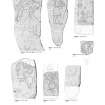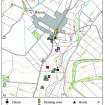Rhynie, Barflat
Pictish Symbol Stone (Pictish)
Site Name Rhynie, Barflat
Classification Pictish Symbol Stone (Pictish)
Alternative Name(s) Rhynie Graveyard, Mid Stone; Rhynie No. 8
Canmore ID 17219
Site Number NJ42NE 53
NGR NJ 497 262
NGR Description NJ c. 497 262
Datum OSGB36 - NGR
Permalink http://canmore.org.uk/site/17219
- Council Aberdeenshire
- Parish Rhynie
- Former Region Grampian
- Former District Gordon
- Former County Aberdeenshire
Rhynie 8, Barflat, Aberdeenshire, Pictish symbol stone
Measurements: H 0.43m, W 0.39m, D 0.16m
Stone type: pink granite
Place of discovery: NJ c 497262
Present location: in a shelter at Rhynie Kirkyard.
Evidence for discovery: found after ploughing in 1978 in a field to the south of the old kirkyard at Rhynie.
Present condition: broken and incomplete, the slab has also been trimmed.
Description
There are three symbols incised by pecking on one broad face of this slab. At the top is the Pictish beast facing right, and below is the top part of an S-shaped figure and a single-sided comb. Below the comb is an arc which may be the top of a mirror but, if so, it would have overlain the S-shaped symbol. The carving of the arc uses a broader groove than the symbols and it may be a later addition.
Date: seventh century.
References: Shepherd & Shepherd 1978; Fraser 2008, no 43.8.
Desk-based information compiled by A Ritchie 2017
Reference (1978)
NJ42NE 53 c. 497 262.
Found in 1978 in the area SSE of the Craw Stane; now at Barflat steading (See NJ52NW 32). Fragment of a larger granite block which has been broken and squared-off subsequent to the carving of the symbols. It is 0.43m long, 0.39m wide and 0.16m thick and bears the outline of a beast, surmounting a comb and a (now truncated) S-shaped figure.
I A G Shepherd and A N Shepherd 1978; 1980.
Reference (1994)
A broken slab of pink granite discovered in the course of ploughing in 1978 (0.43m by 0.39m by 0.16m thick) bears an incised 'beast', a curvilinear symbol and a comb. Now at Grampian Regional Council headquarters, Woodhill House, Ashgrove Road West, Aberdeen.
RCAHMS 1994.
Note (May 2017)
Discovering a Lost People
Modern day Rhynie is a rural village in central Aberdeenshire, surrounded by open countryside. It is a picturesque location, and deceptively modest, for archaeological evidence attests to many centuries of high status settlement in the area. Even the name Rhynie itself is regal, deriving from 'Rig' meaning King. Many Pictish stones have been found here, including the famous 'Rhynie Man', a 6ft high figure carrying an axe, found in a field in 1978.
So who were the Picts, and what were they doing at Rhynie? These are the very questions which are currently being investigated by The University of Aberdeen's Northern Picts project. The project aims to find the Picts in the landscape of Northern Scotland, and has had many notable successes in recent years. The Rhynie Environs Archaeology Project (REAP) is a key case study within the Northern Picts project. It is a collaborative endeavor between the Universities of Aberdeen, Chester and Glasgow and the local community artist collective Rhynie Woman.
Excavations in 2011 and 2012 revealed a series of fortified enclosures near to the the Craw Stane, a Class I Pictish symbol stone which still stands today. This is located at Barflat, northwest of the present day village and very close to where Rhynie Man was found in the 1970s. Early indications were that this was an important settlement. Further work revealed a series of concentric enclosures centred on a ring ditch and other possible timber structures, and in association with the Class I symbol stone. An interpretative reconstruction of the site has recently been completed and it is available to view online. You can access it by clicking on the link below.
Settlement evidence for this period is very rare, and the evidence for Pictish buildings which has been found at Rhynie is extremely important. Equally significant is the evidence for large-scale high status metalworking at the site, and a range of Continental imports which have been found here, indicating without doubt that Rhynie was an important power centre dating from the 4th to the 6th centuries AD. A contemporary cemetery has been found closer to the village.
Contextualising Rhynie / Moulds and Metal
The Rhynie Environs Archaeology Project is investigating the interaction between the high status site here and the wider landscape. The complex at Barflat is close to two small fortified sites at Cairnmore and Wheedlemont, and the great hillfort at Tap O'Noth [see previous Archaeology InSites feature under Age of Iron]. A 5th/6th century phase has been identified at Cairnmore and it is very likely that both Wheedlemont and Tap were in use at this time, but connections between these sites and Rhynie are still to be established. Understanding the links between these sites, and indeed if they are there at all, is key to understanding the development and control of the landscape of the Strathbogie area.
Rhynie has yielded a rich assemblage of high status material. One of the most iconic finds from the site is the axe shaped pin which was found in 2012. This pin, with its serpent design, resembles the axe which is carried by Rhynie Man, now in the reception area of Woodhill House, the headquarters of Aberdeenshire Council. The 2016 excavations revealed the best evidence yet for high status metalworking at Rhynie. Over 50 sherds of crucibles were found at the site, and clay moulds were uncovered in greater numbers than at any other known Pictish site. These moulds produced a range of different pins and brooches. There was even evidence for enameling. The finds from the 2016 season are currently undergoing conservation work, and although less visually striking than the finished products, they have the potential to tell us far more.
Dr Kirsty Owen - Archaeology and World Heritage Team
























